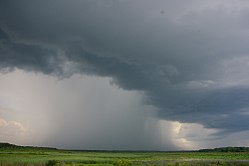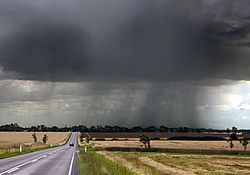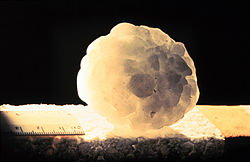Precipitation
(Redirected from Precipitation (meteorology))
Precipitation is the falling of water from the atmosphere. It is a term in meteorology, and includes rain, snow, sleet, ice pellets, dew, frost, and hail. These form by condensation from atmospheric water vapor, and fall under gravity.
Fog and mist are not precipitation but suspensions. In that case, the water vapor does not condense sufficiently to precipitate.
If liquid, precipitation can be measured using a rain gauge. The most common form of solid precipitation is snow. Snow is made when temperatures are so cold that water vapor changes directly to solid crystals. Frozen rain is hail or ice pellets.
Precipitation Media
Condensation and coalescence are important parts of the water cycle.








